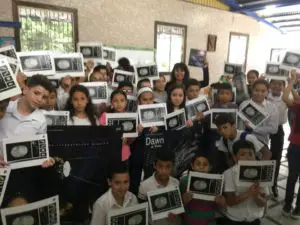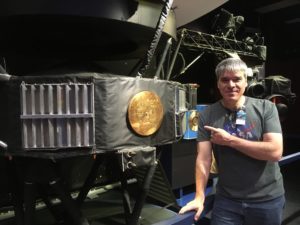Teacher and co-author of the book To The Stars: Costa Rica in NASA recently returned from a visit to NASA’s Jet Propulsion Laboratory (JPL) where he met with Costa Ricans who work there as well as the Voyager mission team. Launched in 1977 the Voyager 1 and 2 spacecraft are exploring where no Earth ship has flown before as they embark on their interstellar journeys. Readers can track the progress of the Voyager probes click here.

Santa Ana elementary school students from the Escuela de la Republica de Francia and the Escuela Juan Alvarez Azofeifahad the unique opportunity to converse with various members of the Voyager team. Below is the Q&A.
What is so special about the Voyager probes’ motor and fuel that have allowed them to keep working for so long? How much longer will they keep sending signals back to Earth?
Ismael Vargas
The Voyager probes don’t have a mechanical motor like a car instead they have chemical rockets (thrusters) that use hydrazine for fuel. The Voyagers were launched in 1977 with 104 Kilograms of hydrazine which is enough to last past 2040. AS for the electrical power, they use three Radioisotope Thermoelectric Generators power by Plutonium-238. At launch the RTGsgenerated about 470 Watts of power, right now they generate about 250 Watts which is enough to keep them going past 2025.
The voyagers will keep sending information back to earth past 2025 when they run out of electrical power.
Enrique Medina
Attitude and Articulation Control Engineer
What materials were the Voyager probes made of that have prevented them from deteriorating after so many years in space? Will NASA’s new probes last as long as the Voyager probes?
Owen Vilchez
The simple answer is aluminum. The biggest threat to the long-term life of the Voyagers is the radiation that exists in space. The radiation streams from the sun and some of it is caught and trapped in the magnetic fields at Jupiter and Saturn. Between the planets the radiation intensity relatively low, but at the planets, it is quite intense. Now the most sensitive part ofthe spacecraft when it comes to radiation is the electronics in Voyager’s computers and science instruments and the best way to shield the electronic parts from the damaging radiation is to surround them with aluminum. While really any metal would do, aluminum is lightweight, strong, and inexpensive and is the perfect material to keep Voyager safe.
Chris Jones
JPL Chief Engineer

What things have the Voyager probes discovered that are of benefit to us here in on Earth?
Axel Ramos
Below are just some of the discoveries of the Voyager Mission. Each one of these and more provides information and data for the next follow-on missions to study the outer planets and to characterize the environment of Interstellar Space. Voyagers are the Interstellar Ambassadors of Space Science.
— Jupiter’s turbulent atmosphere with dozens of interacting hurricane-like storm systems.
–– Erupting volcanoes on Jupiter’s moon Io, which has 100 times the volcanic activity of Earth.
— The Io torus, a thick ring of ionized sulfur.and oxygen shed by Io that inflates Jupiter’s giant magnetic field.
–– An indication of an ocean beneath the cracked icy crust of Jupiter’s moon Europa.
— Waves and fine structure in Saturn’s icy rings from the tugs of nearby moons, and small moons shepherding the narrow, kinky F-ring.
–– A deep, smoggy nitrogen atmosphere on Saturn’s moon Titan, likely having clouds and rain of methane.
–– Complex and diverse surfaces of frozen moons shaped by icy volcanism and faults.
— Neptune’s Great Dark Spot and 1,600 kilometer-per-hour winds (1,000 miles per hour).
–– Geysers erupting from the polar cap.Neptune’s moon Triton at -390 degrees Fahrenheit.
—The termination shock where the supersonic solar wind abruptly slows, forming the final frontier of the solar system.
What reaction do you hope for if Voyager Golden Record of Earth sounds is heard by aliens?

From the grade 3 class of Escuela de la Republica de Francia
Wow, it happened! Intelligent Aliens from far away heard the Earth sounds from Voyager’s Golden Record. Dr. Carl Sagan wanted the Golden Record to be found by extraterrestrials in the interstellar space, to share with them our magnificent Earth.
We want the Aliens to be amazed, to be joyful, to be curious reaching out to us. They can reach out to us from the precise location of our Solar System referenced by the 14 pulsars engraved on the cover. There are many questions the Voyager team would like to ask them about their encounter of the Golden Record.
What did the Aliens hear from the Golden Record? There are greetings in fifty-five different languages, 90-minute of music, varies from classical to pop music from different ethnic cultures, and variety of natural sounds from Earth. Who played the Golden Record? How did they play the Golden Record? We are interested in knowing whether the Aliens who played the Earth sounds have seen the 115 images on the Golden Record. These images captured human’s daily life events, for examples, shopping in a supermarket, Celebration in a Chinese wedding banquet, people drinking and eating, the picture of Earth from the spaces, scientific diagrams with human body anatomy, baby fetus, DNA structure, chemical composition, scenes of nature, and many others. Did they learn more about us after seeing the photos? Can they put the puzzles together with the Earth sounds and the images? Can they see us clearly from the time capsule sent by the Voyager spacecraft?
Do you have a time capsule of your civilization? We will be amazed, joyful, and delighted to receive one from you. We are looking forward to hearing from you.
Adams Ko
(Science Data Management and Sequence Engineer)
What are the biggest challenges for your team to operate space probes that were built with 1970’s technology?

Students from Escuela Juan Alvarez Azofeifa
The biggest challenge is the extremely long distance between the spacecraft and the Earth. For example, Round Trip Light Time for Voyager 1 today (11/15/16) is over 38 hours whereas it’s only about 10 to 30 min for the Mars probes. The aging hardware after nearly 40 years in space, decreasing RTG power, difficulty in obtaining Deep Space Network coverage, and disappearing knowledge base also present a huge challenge for us. In addition, we have to work with the limited memory of onboard computers, antiquated programming languages, and the lack of a hardware testbed.
Sun Kang Matsumoto
Voyager Fault Protection and CCS Flight Software Systems Engineer
